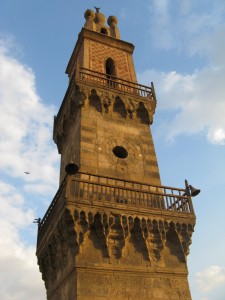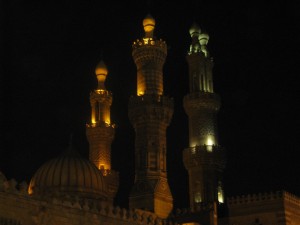 You don’t get a nickname like the City of a Thousand Minarets without having earned it. A quick look at the Cairo skyline cements the Egyptian capital’s claim to the title: Everywhere you look, the spindled towers of mosques old and new puncture the clouds.
You don’t get a nickname like the City of a Thousand Minarets without having earned it. A quick look at the Cairo skyline cements the Egyptian capital’s claim to the title: Everywhere you look, the spindled towers of mosques old and new puncture the clouds.
Rarely has a city been so cozy with ancient history. Cairo’s 20-plus million souls regularly pray in mosques centuries old; the call to prayer punctuates dawn and dusk from the same minarets it did in the Mamluk and Ottoman eras.
Even an extended stay in the city won’t net you views of all the places of worship on offer, but a tour of the biggest and best of Cairo’s mosques will have any traveler thinking in superlatives.
The Oldest
Today, mosques are commonplace in Egypt and Africa. They owe a debt to the Mosque of Amr Ibn El-As. Built in 642 AD, it was the first mosque on the continent, an outpost on the frontline of Islam’s spread. It is named after the man who won Egypt for Islam, Amr Ibn El-As.
History has not been kind to the forerunner of Cairo’s places of worship: While a sizable mosque sits on the site today, renovations and architectural patchwork have left little of the original structure intact. But the restorations and additions hold their own. The Mosque of Amr incorporates the columns from old churches and intricate wooden carvings in its design, making this first mosque, adjacent to Cairo’s Coptic Christian quarter, well worth a look.
The Most Important
The mosque of Al-Azhar and the university named after it are the closest thing Islam has to the Christian papacy. Here, generations of students have memorized the Qu’ran, studied Islamic law and lost sleep over the intricacies of classical Arabic grammar, while venerable scholars deliver religious rulings on the issues of the day. They continue to do so today, performing daily devotions under the long gaze of the mosque’s three minarets. And they’ve been doing so for a long time: Al-Azhar was built in 970 AD by the general Jawhar Al-Siqilly, the man who conquered Egypt for the Fatimid dynasty.
Since, the mosque has grown. It has sprouted architectural additions and decorations like a venerable tree sprouts branches and roots. In 1138, an arcade wrapping around the mosque’s main courtyard was built. The Mamluk dynasty constructed their own schools on the mosque grounds in the 14th century. A new minaret was added in the mid-15th century.
Today, Al-Azhar sits at the hub of Cairo’s largest tourist market, Khan El-Khalili, and the neighborhoods that surround it. A small tip to the men minding the shoes and you can spend some time in the cool arcades, enjoying rare Cairo breezes and another commodity the capital is starved for: peace and quiet. If you’re lucky, you can convince one of the mosque’s minders to unlock the door to one of the minarets. It’s not considered improper, it just might cost you and you’ll be asked to leave if prayers begin during your visit.
 The Grandest
The Grandest
After any length of time in Cairo, you’ll see the mosque of Muhammed Ali and the fortress it abuts, long before you visit it. That’s because the mosque and the Citadel were meant to be shown off. The fortress complex, a key defensive position and a seat of government until the early 20th century, dominates Old Cairo’s skyline.
Vast domes cap the structure, reminiscent of Turkish architecture. That’s fitting because the building was commissioned by Muhammed Ali Pasha, the self-declared ruler of Egypt in the time of the Ottoman sultanate. Built between 1828 and 1848, the mosque sits on the site of one of the Muhammed Ali’s triumphs: the bloody eradication of the vestiges of Egypt’s Mamluk elite. In what would become one of the deadliest dinner parties in history, Muhammed Ali massacred the Mamluks invited to dine one evening at the Citadel.
Today, the place’s hospitality has improved. Tour groups and the devout alike marvel at its massive interior and its intricate central dome, framed by four full domes and a clutch of half-domes that bring to mind Imperial Turkey. The mosque doesn’t just carry its benefactor’s name; it is also his final resting place. The bones of Muhammed Ali are interred in a marble tomb viewable in one corner of the mosque’s interior. He died a year after the mosque was completed, after spending the better part of his life ruling and modernising Egypt.
The Holiest
Located just across the road from Al-Azhar, the Mosque of Hussein is named for the son of Ali, the Prophet’s son-in-law, hence its importance. The oldest part of the mosque, the mausoleum built to (supposedly) inter Hussein’s remains brought from Iraq, was built in 1154.
The vast crowds that pray regularly at the mosque have spurred modern additions, namely gargantuan steel umbrellas fronting the square outside the mosque. In the punishing heat, these umbrellas unfurl to protect the spiritual from the merciless eye of the sun.
After journeying to some of Cairo’s most spectacular holy places, your next move is to buy a return ticket. After all, you’ve got nearly a thousand other mosques to go.

